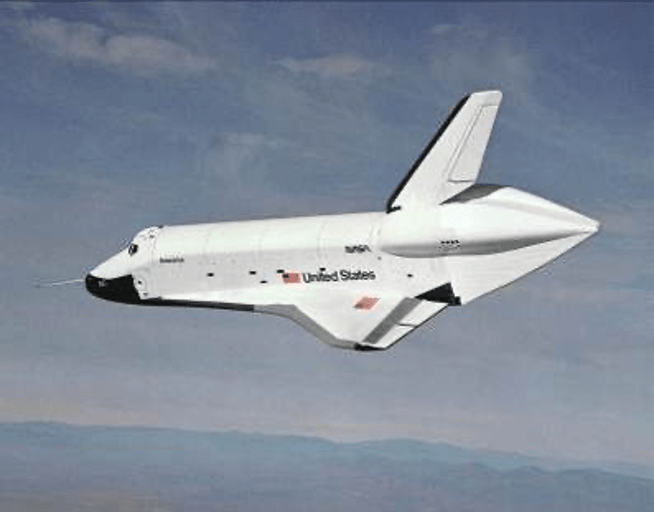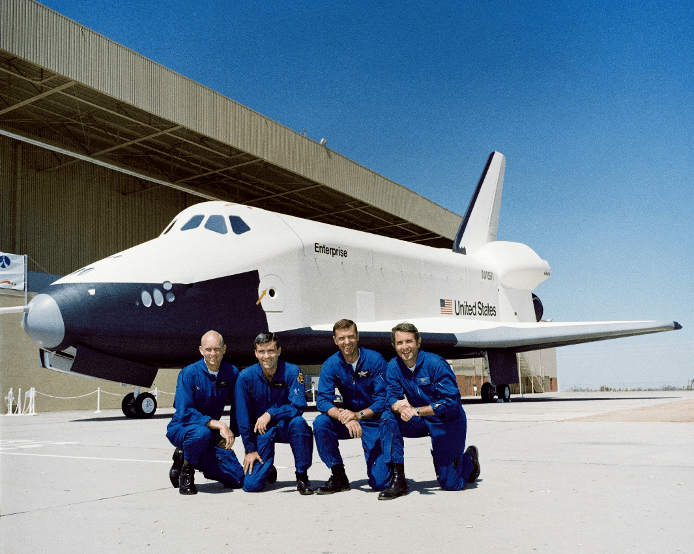640. Enterprise
On this page:
Location: Flight Deck/Shuttle Pavilion

Fast Facts
Enterprise, known to NASA as OV-101, was completed in 1976. Enterprise was a prototype, the first of its kind and conducted critical tests within Earth’s atmosphere in 1977. These pioneering tests paved the way for the orbital flights of later shuttles, beginning with the first flight of the space shuttle Columbia in 1981.

Exhibit Description
You will not immediately see the Enterprise when you enter the Space Shuttle Pavilion, you must first navigate a long tunnel and at the end you will emerge under the right wing of the orbiter. Most people’s first impression is that the Enterprise is much larger than they expected. The wing you are standing under is almost 10 feet (3 meter) from the deck. As you walk under and around the orbiter you will notice that the landing wheels are in the down position and that each main wheel tire is just under 4 feet (1.2 meter) in diameter.
The orbiter is primarily just two colors, black and white. The entire belly and nose of the orbiter is black. On the orbiters that went to space, this area is completely covered with the famous insulation tiles, as these areas are subjected the most to the blistering heat of reentry.
The best place to see the entire vehicle at once is from the view deck just in front of the nose. The view deck can be accessed from the stairs on the left or the elevator to the right.
From the view deck, you will notice that the body of the orbiter is like a long box. That is because there is a 60 foot (18.2 meter) long by 15 foot (4.5 meter) diameter payload bay between the cockpit and the vertical tail. Two huge doors on the top of the orbiter can open to load the cargo, and once again when the spacecraft reaches orbit in order to deploy its contents.
Photos & Videos
Video description: Retired NASA astronaut Mike Massimino stands under the orbiter Enterprise in the Space Shuttle Pavilion. Using his unique perspective, having flown on two space shuttle missions, Massimino explains the history and challenges of the shuttle program. Historical videos and images are used throughout to further illustrate important details.


More information
The space shuttle blended rocket and airplane technology. Enterprise was a prototype—an early model—that conducted critical tests of this new design. NASA intended to use Enterprise for atmospheric tests and then refit it for spaceflight.
The story of Enterprise’s name illustrates how popular culture can inspire science. This prototype orbiter was originally named “Constitution” in honor of the nation’s bicentennial in 1976. It was scheduled to be unveiled on Constitution Day, September 17, 1976. However, more than 400,000 fans of the television show Star Trek successfully petitioned President Gerald Ford to change the name to Enterprise in celebration of the series’ fictional starship.Because Enterprise was an atmospheric test vehicle, it was only fitted to a certain extent. Enterprise did not need the protective thermal tiles and reinforced carbon-carbon components of later orbiters. It did not require larger systems such as radar, main engines or even a toilet.
After Enterprise was completed, NASA made additional changes to the overall space shuttle design. As a result, NASA determined that retrofitting Enterprise for spaceflight would be very expensive. Instead of orbiting Earth, Enterprise traveled around the globe serving as an ambassador to educate the public about the Space Shuttle Program.
NASA’s orbiter fleet numbered six in all. The first, Enterprise, tested the concept of a reusable spacecraft that could land like an airplane. Plans to modify it for spaceflight would never be realized. Instead, five other orbiters were built.
Each orbiter has a 60-foot-long (18.29 meter) payload bay and a robotic arm to deliver equipment and satellites into Earth orbits of 115 to 400 miles high (185 to 644 kilometers). They carried laboratories, space probes, and segments of the International Space Station, the largest spacecraft ever.
NASA referred to the orbiters by their alphanumeric designations, such as “OV-101” for Enterprise. The orbiters that were intended for spaceflight were numbered in the 100 series. Challenger, OV-099, was an exception as it was originally built as Structural Test Article-099. NASA determined that it would be less expensive to modify Challenger for space than it would be to modify Enterprise. Thus, Challenger became 0V-099.
The orbiters flew for 30 years, taking 355 individuals from 16 different nations to space. NASA retired the shuttle fleet in 2011. NASA wanted to repurpose Enterprise and the other surviving decommissioned orbiters, Discovery, Atlantis and Endeavour, as educational inspirations. Several American museums competed to serve as the permanent homes of these historic artifacts. Enterprise was awarded to the Intrepid Sea, Air & Space Museum, making it the first NASA vehicle in our collection.
Enterprise’s journey from Washington, D.C. to New York City in 2012 was a complex feat of engineering. Enterprise flew to John F. Kennedy International Airport atop the same modified 747 jetliner that carried it in the 1970s. A barge transported the orbiter from Queens to Pier 86 in Manhattan, navigating the waters of Jamaica Bay, New York Harbor and the Hudson River.
Enterprise is the only space shuttle orbiter in the Northeast region. On March 13, 2013, Enterprise became the first space shuttle to be listed on the National Register of Historic Places.
Statistics
| Length: | 122 ft 2.0 in (37.237 m) |
| Wingspan: | 78 ft 1 in (23.79 m) |
| Height: | 58 ft 7 in (17.86 m) |
| Crew: | Two |
| Service Date: | September 1976 to November 1985 |
| Missions: | Five atmospheric glide tests |